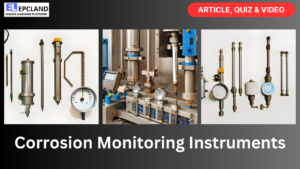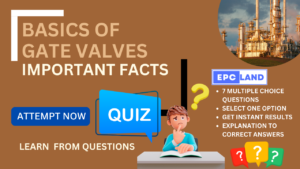1. Sheet Gaskets as Types of Gasket
Which of the following materials is commonly used to make sheet gaskets which is considered as Types of Gasket?
Explanation: Sheet gaskets are commonly made from non-metallic materials such as rubber, neoprene, cork, or Teflon.
2. Spiral Wound Gaskets
What is the composition of a spiral wound gasket?
Explanation: Spiral wound gaskets consist of a metal spiral wound between layers of a non-metallic filler material, such as graphite or asbestos.
3. Solid Metal Ring Gaskets
What is the typical material used to make solid metal ring gaskets?
Explanation: Solid metal ring gaskets are made from a solid ring of metal, such as steel, stainless steel, or aluminum.
4. Sheet Gaskets Advantages
What is one advantage of using sheet gaskets?
Explanation: One advantage of sheet gaskets is that they are inexpensive and easy to install.
5. Spiral Wound Gaskets Resilience
Why are spiral wound gaskets considered more resilient than sheet gaskets?
Explanation: Spiral wound gaskets are considered more resilient than sheet gaskets because they are less susceptible to creep and deformation.
6. Solid Metal Ring Gaskets Durability
Why are solid metal ring gaskets considered the most durable?
Explanation: Solid metal ring gaskets are considered the most durable because they are made from a solid ring of metal.
7. Gasket Types Comparison
What advantage do solid metal ring gaskets have over sheet gaskets and spiral wound gaskets?
Explanation: Solid metal ring gaskets are considered the most durable among the three types, making them suitable for high-pressure, high-temperature applications where reliability is crucial.
Short Article on Types of Gasket
Different Types of Gasket
three gasket types typically used in pipe flanges for process plant applications:
Sheet Gaskets
Sheet gaskets are made from a variety of non-metallic materials, such as rubber, neoprene, cork, or Teflon. They are typically used in low-pressure, low-temperature applications. Sheet gaskets are relatively inexpensive and easy to install, but they can be susceptible to creep and deformation, which can lead to leakage.
Spiral Wound Gaskets
Spiral wound gaskets are a type of composite gasket that consists of a metal spiral wound between layers of a non-metallic filler material, such as graphite or asbestos. They are typically used in high-pressure, high-temperature applications. Spiral wound gaskets are more resilient than sheet gaskets and are less susceptible to creep and deformation.
Solid Metal Ring Gaskets
Solid metal ring gaskets are made from a solid ring of metal, such as steel, stainless steel, or aluminum. They are typically used in high-pressure, high-temperature applications where the highest level of reliability is required. Solid metal ring gaskets are the most expensive type of gasket, but they are also the most durable.
Here is a table summarizing the key characteristics of each type of gasket:
| Gasket Type | Material | Typical Applications | Advantages | Disadvantages |
|---|---|---|---|---|
| Sheet | Non-metallic | Low-pressure, low-temperature applications | Inexpensive, easy to install | Susceptible to creep and deformation |
| Spiral wound | Metal spiral wound between layers of non-metallic filler | High-pressure, high-temperature applications | Resilient, less susceptible to creep and deformation | More expensive than sheet gaskets |
| Solid metal ring | Solid ring of metal | High-pressure, high-temperature applications where the highest level of reliability is required | Most durable | Most expensive |
Table of Contents
Don’t miss the Course on Effective Isometrics Management: Check Now
Enrollment Link
Recommended courses (Published on EPCLand)
- Complete Course on Piping Engineering
- Basics of Piping Engineering
- Piping Layout Engineering
- Piping Material Engineering
- Piping Stress Analysis
- Material Requisitions
- Piping Material Specifications
- Valve Material Specifications
- Plant Design & Layouts-OISD 118
- Isometric Management
Library of Technical Articles
Don’t miss out the collection of 15+ articles on following topics:
- Basics of Oil and Gas Industry
- Valves
- Testing
- Tank
- Piping Bulk Items
- Pipe
- Metallurgy
- Piping Materials
- Layout
- Instrumentation
- Heat Exchanger
- Type of Contracts
- Codes and Standards
- ASTM Standards
- Articles on Piping Specialty Items
Video details of Complete Course on Piping Engineering
Why Enroll in the EPCLand
Proven Track Record– PTR
Activities & Achievements before launching EPCLand
- Published more than 50+ short courses
- 3000+ Enrolments
- More than 3,500,00 Minutes of watch hours in the last 2 years
- 4000+ Students in 100+ Countries
- Rating of 4+ out of 5
- 1000+ YouTube Videos
- 8K+ Subscribers
What Students will Learn
- Codes & Standards of the Energy Sector
- Piping Material Engineering
- Piping Layout Engineering
- Stress Analysis
Interesting facts
- All the published courses have been developed by Industry Experts with more than 2 decades of experience
- Content is based on Practical experience and real-time problems.
- Content is designed and organized in such a manner that it can be easily grabbed.
- Complete website, Blogs and Quiz sections are Planned, Designed and published by myself (About me: Atul Singla)
- Complete flexibility of Time & Location, Students can access the content from anywhere & anytime
- Moreover, once enrolled, the content can be access as many times as you want, which helps in understand the fundamentals in a better way.
Conclusion
In conclusion, our courses are meticulously crafted by industry experts with over two decades of hands-on experience. The content is rooted in practical knowledge, addressing real-time problems. The material is thoughtfully designed and organized for easy comprehension. Every aspect, from the website to blogs and quizzes, has been planned, designed, and executed by Atul Singla, ensuring a comprehensive and seamless learning experience. With the flexibility of accessing the content at any time and from any location, students have the freedom to learn on their terms. Furthermore, enrollment grants unlimited access, allowing learners to revisit the material as often as needed, fostering a deep understanding of the fundamentals.



